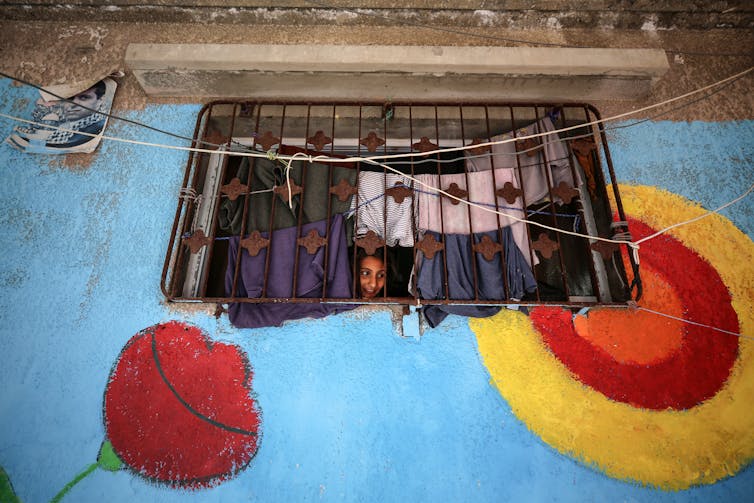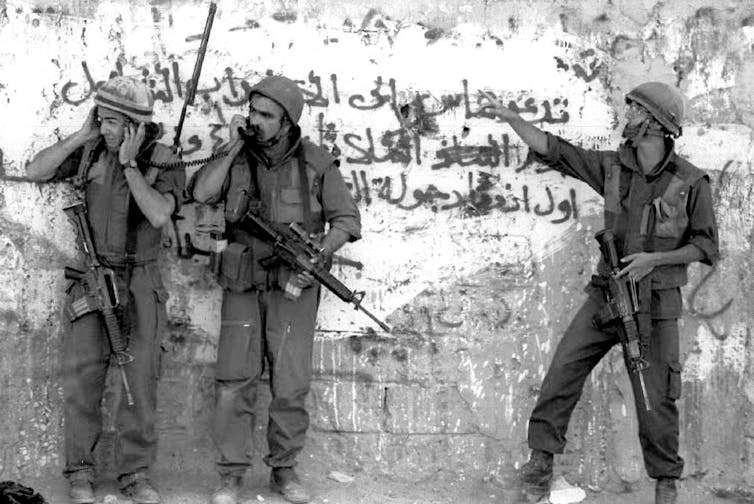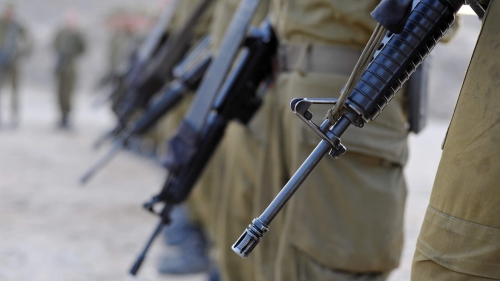Gaza: History of the Densely Populated Enclave

The focus on conflict in the Middle East has again returned to the Gaza Strip, with Israel’s defense minister ordering a “complete siege” of the Palestinian enclave.
The military operation, which involves extensive bombing of residences, follows a surprise attack on Oct. 7, 2023, by Hamas militants who infiltrated Israel from Gaza and killed around 1,200 Israelis. In reprisal airstrikes, the Israel military has killed over 1,400 Gazans. And that figure could escalate in the coming days. Meanwhile, an order to cut off all food, electricity and water to Gaza will only worsen the plight of residents in what has been called the “world’s largest open-air prison.”
But how did Gaza become one of the most densely populated parts of the planet? And why is it the home to militant Palestinian action now? As a scholar of Palestinian history, I believe understanding the answers to those questions provides crucial historical context to the current violence.
A brief history of Gaza
The Gaza Strip is a narrow piece of land on the southeastern shore of the Mediterranean Sea. Roughly twice the size of Washington, D.C., it is wedged between Israel to its north and east and Egypt to its south.
An ancient trade and sea port, Gaza has long been part of the geographic region known as Palestine. By the early 20th century, it was mainly inhabited by Muslim and Christian Arabs who lived under Ottoman rule. When Britain took control of Palestine following World War I, intellectuals in Gaza joined the emergent Palestinian national movement.
During the 1948 war that established the state of Israel, the Israeli military bombed 29 villages in southern Palestine, leading tens of thousands of villagers to flee to the Gaza Strip, under the control of the Egyptian army that were deployed after Israel declared independence. Most of them and their descendants remain there today.
Following the 1967 Six-Day War between Israel and its Arab neighbors, the Gaza Strip came under Israeli military occupation. The occupation has resulted in “systematic human rights violations,” according to rights group Amnesty International, including forcing people off their land, destroying homes and crushing even nonviolent forms of political dissent.
Palestinians staged two major uprisings, in 1987-1991 and in 2000-2005, hoping to end the occupation and establish an independent Palestinian state.
Hamas, a Palestinian Islamist militant group centered in Gaza, was founded in 1988 to fight against the Israeli occupation. Hamas and other militant groups launched repeated attacks on Israeli targets in Gaza, leading to Israel’s unilateral withdrawal from Gaza in 2005. In 2006, Palestinian legislative elections were held. Hamas beat its secular rival, Fatah, which had been widely accused of corruption. Elections haven’t been held in Gaza since 2006, but polling from March 2023 found that 45% of Gazans would back Hamas should there be a vote, ahead of Fatah at 32%.
After a brief conflict between Hamas and Fatah militants in May 2007, Hamas took complete control of the Gaza Strip. Since then, Gaza has been under the administrative control of Hamas, even though it is still considered to be under Israeli occupation by the United Nations, the U.S. State Department and other international bodies.
Who are the Palestinians of Gaza?
The more than 2 million inhabitants of the Gaza Strip are part of the 14 million-strong global Palestinian community. About one third of Gaza’s inhabitants trace their family’s roots to land inside the Gaza Strip. The remaining two-thirds are refugees from the 1948 war and their descendants, many of whom hail from towns and villages surrounding Gaza.

The Palestinians of Gaza trend young: nearly half the population is under 18. The enclave is also very poor, with a poverty rate that stands at 53%. Despite this grim economic picture, education levels are quite high. Over 95% of Gazan children ages 6-12 are in school. The majority of Palestinian students in Gaza graduate from high school, and 57% of students at the prestigious Islamic University of Gaza are female. But because of the circumstances of their surroundings, young Palestinians in Gaza find it difficult to live fulfilling lives. For graduates between the ages of 19 and 29, the unemployment rate stands at 70%. And a World Bank survey earlier this year found 71% of Gazans show signs of depression and high levels of PTSD.
There are several factors that contribute to these conditions. A major factor is the crippling, 16-year blockade that Israel and Egypt – with U.S. support – have imposed on Gaza.
Years of blockade
Shortly after the 2006 elections, the Bush administration tried to force Hamas from power and bring in a rival leader from the Fatah party who was considered friendlier to Israel and the U.S. Hamas preempted the coup and took full control of Gaza in May 2007. In response, Israel and Egypt – with U.S. and European support – closed the border crossings into and out of the Gaza Strip and imposed a land, air and sea blockade.
The blockade, which is still in effect, limits the import of food, fuel and construction material; limits how far Gaza’s fishermen can go out to sea; bans almost all exports; and imposes strict limitations on the movement of people into and out of Gaza. In 2023, Israel has allowed only around 50,000 people a month to exit Gaza, according to U.N. figures.
The years of closure have devastated the lives of Palestinians in Gaza. Inhabitants there don’t have enough water for drinking and sanitation. They face electricity cuts that run 12 to 18 hours each day. Without adequate water and electricity, Gaza’s fragile health care system is “on the brink of collapse,” according to the medical rights group Medical Aid for Palestine.
These restrictions hit the young and the weak of Gaza particularly hard. Israel routinely denies sick patients the permits they need to receive medical care outside of Gaza. Bright students with scholarships to study abroad often find that they are unable to leave.
U.N. experts say this blockade is illegal under international law. They argue that the blockade amounts to a collective punishment of the Palestinians of Gaza, a violation of the Hague Convention and the Geneva Conventions that form the backbone of international law.
No end to the suffering
Israel says that the blockade on Gaza is necessary to secure the safety of its population and will be lifted when Hamas renounces violence, recognizes Israel and abides by previous agreements.
But Hamas has consistently rejected this ultimatum. Instead, militant fighters stepped up the firing of homemade rockets and mortars into populated areas surrounding the Gaza Strip in 2008, seeking to pressure Israel to lift the blockade. They have sporadically attacked Israel in this way in the years since.

Israel has launched four major military assaults on Gaza – in 2008-09, 2012, 2014 and 2021 – in efforts to destroy Hamas’ military capabilities. Those wars killed 4,000 Palestinians, more than half of whom were civilians, along with 106 people in Israel.
During that time, the U.N. estimates that there has been more than $5 billion worth of damage to Gaza’s homes, agriculture, industry, electricity and water infrastructure.
Each of those wars ended in a fragile cease-fire but no real resolution to the conflict. Israel seeks to deter Hamas from launching rockets. Hamas and other militant groups say that even when they have upheld previous cease-fires, Israel has continued to attack Palestinians and has refused to lift the blockade.
Hamas has offered a long-term truce in exchange for Israel ending the blockade on Gaza. Israel has refused to accept the offer, sticking to its position that Hamas must first end violence and recognize Israel.
In the months leading up to the latest escalation, conditions in Gaza have deteriorated even further. The International Monetary Fund reported in September that Gaza’s economic outlook “remains dire.” Conditions became more dire when Israel announced on Sept. 5, 2023, that it was halting all exports from a key Gaza border crossing.
Without an end in sight to the suffering caused by the blockade, it appears that Hamas has decided to upend the status quo in a surprise attack on Israelis, including civilians. Israel’s reprisal airstrikes and its imposition of a “complete siege” on the strip have heaped even further suffering on ordinary Gazans.
It is a tragic reminder that civilians bear the brunt of this conflict.
Dr. Maha Nassar is an Associate Professor in the School of Middle Eastern and North African Studies at University of Arizona. She received her Ph.D. in Near Eastern Languages and Civilizations from University of Chicago. She is the author of "Brothers Apart: Palestinian Citizens of Israel and the Arab World" (Stanford University Press, 2017).
( Source: This article is republished from The Conversation under a Creative Commons license. )
Topics: Gaza, History, Human Rights, Palestine
Related Suggestions

















